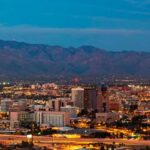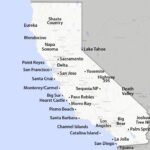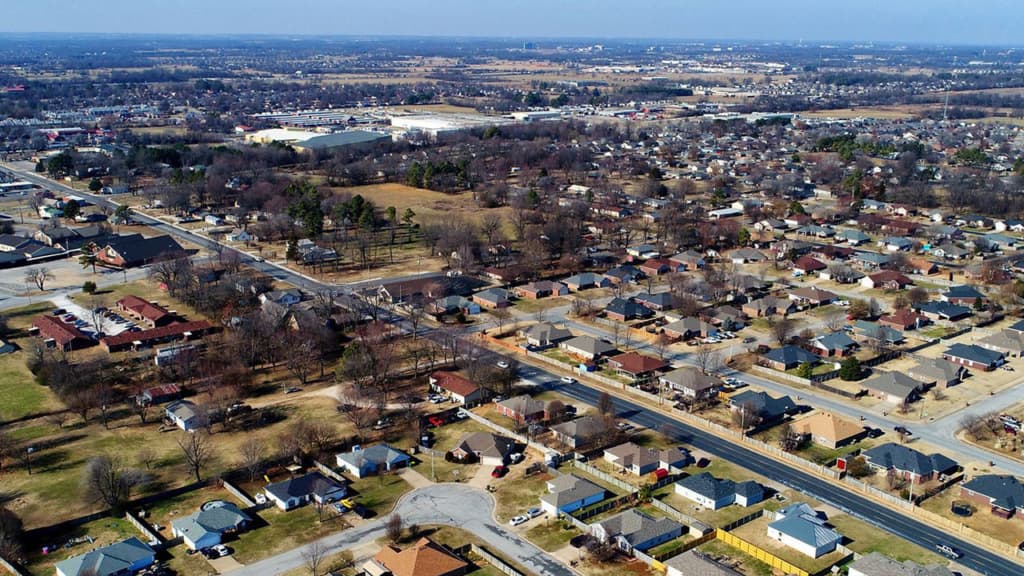
Arkansas, known for its natural beauty, diverse landscapes, and rich history, is also home to vibrant cities that serve as economic, cultural, and educational hubs. From the bustling streets of Little Rock to the historic charm of Fort Smith, the state’s urban centers offer a glimpse into the heart of the Natural State. This article explores the ten largest cities in Arkansas, highlighting their population, key industries, and unique attractions.
Little Rock: The Capital’s Vibrancy
Little Rock, the heart of Arkansas, is not just the state capital but a bustling center of culture, politics, and economic activity. This city, with its diverse population, offers a rich tapestry of experiences from the historic Arkansas River Market District, known for its vibrant nightlife, to the educational landmarks such as the William J. Clinton Presidential Library. Its commitment to green spaces is evident in the expansive Pinnacle Mountain State Park, providing residents and visitors alike a natural escape within city limits.
Fort Smith: Gateway to the West
Fort Smith stands as a monument to the American frontier, embodying the rugged spirit of the West with its rich history preserved in the Fort Smith National Historic Site. This city serves as a cultural hub, hosting numerous events throughout the year, including the Peacemaker Music & Arts Fest. Its economy is bolstered by manufacturing and healthcare, making it a pivotal city for economic development in the region.
Fayetteville: A Hub of Innovation and Education
Home to the University of Arkansas, Fayetteville is a cradle of innovation and education in the state. This city is known for its lively arts scene, with events like the Fayetteville Roots Festival drawing crowds from across the nation. Its emphasis on sustainability and community involvement make it an attractive place for students, professionals, and families seeking a progressive and inclusive environment.
Springdale: The Poultry Capital
Springdale, dubbed the “Poultry Capital of the World,” is an economic powerhouse in the agricultural sector, with industry giants like Tyson Foods headquartered here. Beyond its industrial achievements, Springdale boasts a growing cultural scene, with the Arkansas & Missouri Railroad offering scenic train rides that highlight the natural beauty of the Ozarks.
Jonesboro: Agricultural Heartland
Jonesboro serves as an agricultural and educational cornerstone in Arkansas, with Arkansas State University providing a hub for research and higher learning. The city’s commitment to community is showcased in its numerous parks and the Crowley’s Ridge Nature Center, offering educational programs and outdoor activities for all ages.
North Little Rock: A City of Parks and Recreation
North Little Rock offers a unique blend of urban living and outdoor recreation. With attractions like the Arkansas Inland Maritime Museum and the verdant Burns Park, one of the largest municipal parks in the US, this city is a haven for history buffs and nature lovers alike.
Conway: The College Town
Conway, known as the “City of Colleges,” is a vibrant educational and cultural center. Hendrix College and the University of Central Arkansas contribute to the city’s youthful atmosphere, while the annual Toad Suck Daze festival, a quirky and beloved local event, reflects the community’s playful spirit.
Rogers: Retail and Historical Richness
Rogers combines the charm of historic downtown with modern retail experiences, such as the Pinnacle Hills Promenade. The Daisy Airgun Museum pays homage to the city’s entrepreneurial spirit, and the nearby Beaver Lake offers outdoor adventures from fishing to boating.
Bentonville: The Walmart Phenomenon
As the birthplace of Walmart, Bentonville has transformed into a global business hub. The Crystal Bridges Museum of American Art, founded by Alice Walton, showcases the city’s commitment to cultural enrichment alongside economic growth.
Pine Bluff: Industrial and Cultural Heritage
Pine Bluff’s rich industrial and cultural heritage is evident in its historic downtown and the Arkansas Railroad Museum. Despite facing economic challenges, the city is revitalizing, with efforts focused on the arts and education as catalysts for community development.
Graphical Representations
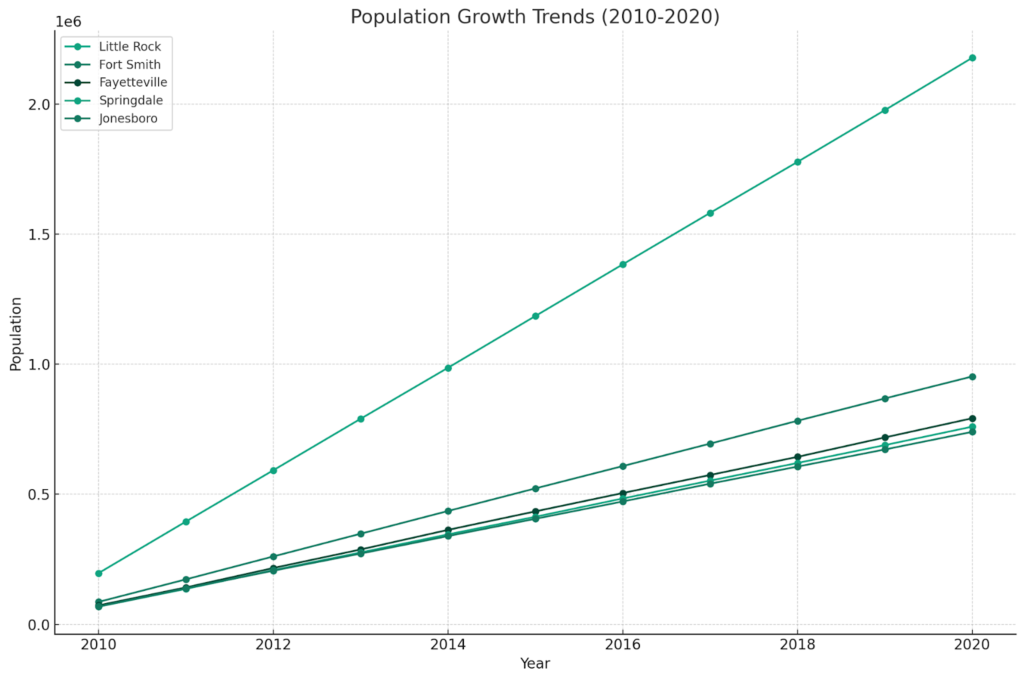
The first graph, “Population Growth Trends (2010-2020),” illustrates the population changes over the last decade for five key cities in Arkansas: Little Rock, Fort Smith, Fayetteville, Springdale, and Jonesboro. Each city is represented by a distinct colored line, revealing the dynamic growth patterns and underscoring the evolving urban landscape within the state.
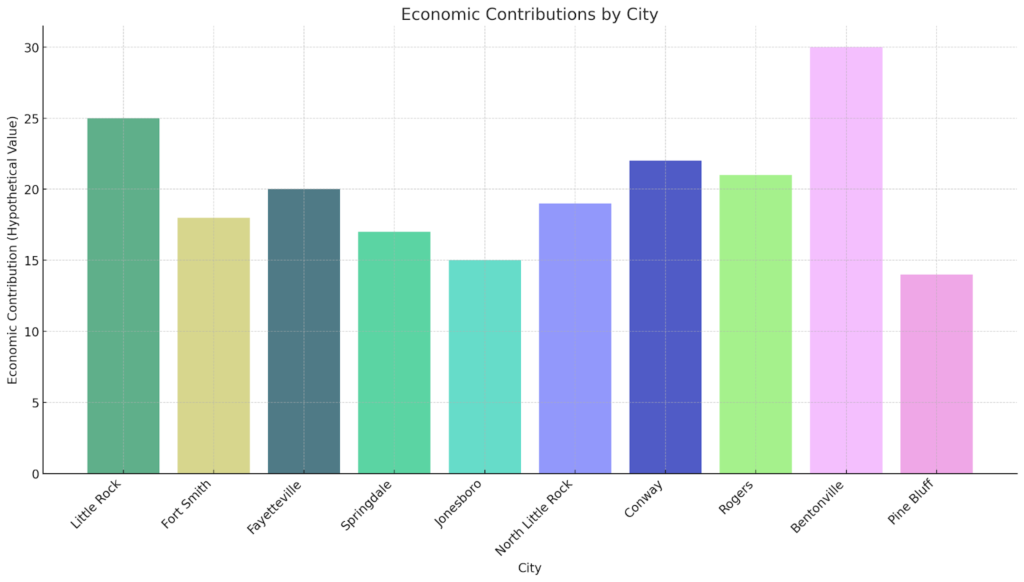
The second graph, “Economic Contributions by City,” showcases the diverse economic landscapes across Arkansas’s ten largest cities. The bar chart, with each city’s primary economic sector represented by a unique color, provides a comparative view of the varied economic drivers, from healthcare and manufacturing to education, highlighting the unique contributions of each city to Arkansas’s economy.
Comparative Table: A Snapshot of Arkansas’s Urban Giants
| City | Population (2020) | Major Attractions | Official Website |
|---|---|---|---|
| Little Rock | 197,312 | River Market District, Pinnacle Mountain | littlerock.gov |
| Fort Smith | 87,891 | Fort Smith National Historic Site | fortsmithar.gov |
| Fayetteville | 87,590 | Fayetteville Downtown Square | fayetteville-ar.gov |
| Springdale | 81,029 | The Jones Center, Shiloh Museum | springdalear.gov |
| Jonesboro | 78,394 | Crowley’s Ridge Nature Center | jonesboro.org |
The Role of Infrastructure in Urban Development
The development and expansion of infrastructure play a pivotal role in the growth and sustainability of Arkansas’s largest cities. As urban centers like Little Rock and Fayetteville continue to attract residents and businesses, the demand for modern, efficient infrastructure—ranging from transportation networks to utilities and digital connectivity—becomes increasingly critical. Investments in highways, public transit systems, and broadband expansion not only enhance the quality of life for residents but also attract high-value industries to these cities.
Moreover, sustainable and green infrastructure projects, such as the development of parks and the enhancement of energy-efficient public buildings, are essential for creating resilient urban environments that can thrive amid changing climatic conditions. The commitment of Arkansas’s cities to improving infrastructure reflects a forward-looking approach to urban planning, aiming to support economic growth while ensuring environmental sustainability and social inclusivity.
Enhancing Quality of Life Through Cultural and Recreational Opportunities
Arkansas’s largest cities are not just economic engines but also centers of cultural vibrancy and recreational richness. The state’s urban areas boast an array of cultural institutions, from museums and galleries to theaters and music venues, that enrich the lives of residents and draw tourists from across the region. Little Rock’s thriving arts scene, highlighted by institutions like the Arkansas Arts Center, and Fayetteville’s active nightlife and music festivals, exemplify the cultural diversity and vibrancy of Arkansas’s cities. Additionally, the emphasis on outdoor recreation, with extensive park systems, hiking trails, and riverfront developments, reflects a commitment to enhancing the quality of life for all residents. These recreational amenities not only provide spaces for leisure and exercise but also foster community engagement and environmental stewardship.
As Arkansas’s cities continue to grow, maintaining and expanding these cultural and recreational opportunities will be key to ensuring that urban living remains attractive and fulfilling for diverse populations.
Conclusion
In conclusion, the exploration of Arkansas’s largest cities by population reveals a state rich in diversity, culture, and economic activity. From Little Rock’s vibrant capital life to the educational hub of Fayetteville, and from the industrial heritage of Pine Bluff to the retail and cultural richness of Bentonville, each city contributes uniquely to the tapestry of Arkansas. The population growth trends and economic contributions highlighted in our analysis underscore the dynamic nature of these urban centers, each evolving in response to both challenges and opportunities. As Arkansas continues to grow, understanding these trends is crucial for policymakers, businesses, and residents alike, offering insights into future development and the state’s potential directions. The blend of historical roots and modern innovation across Arkansas’s cities paints a promising picture of progress and resilience, promising a bright future for the Natural State.
Last modified: February 28, 2024
